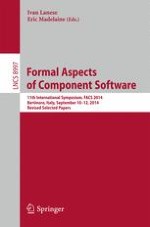This book constitutes revised selected papers from the International Symposium on Formal Aspects of Component Software, FACS 2014, held in Bertinoro, Italy, in September 2014.
The 20 full papers presented in this volume were carefully reviewed and selected from 44 submissions. They are organized in topical sections named: compositional approaches; adaptation and evolution; application and experience; tools; scheduling, time and hybrid systems; other verification approaches and safety and liveness of composition. The volume also contains two invited talks, one full paper and one abstract.
